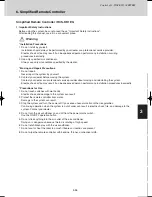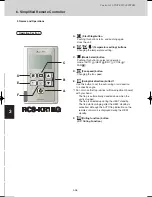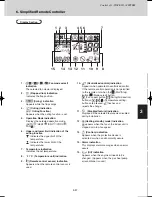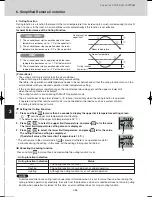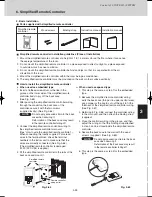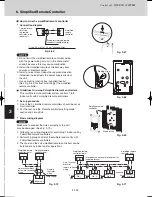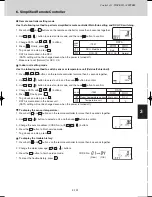
3-99
Control of 3-WAY ECO-i SYSTEM
1
2
3
4
5
6
7
8
6. Simplified Remote Controller
4. Basic Installation
Simplified remote controller installation guidelines (Place of installation)
How to install the simplified remote controller
When used as embedded type
Parts supplied with simplified remote controller
Binding strap
Simplified remote
controller
Wood screws
Instruction manual Installation manual
1. Mount the simplified remote controller at a height of 1 to 1.5 meters above the floor where it can sense
the average temperature of the room.
2. Do not mount the simplified remote controller in a place exposed to direct sunlight or a place exposed
to outside air such as near a window.
3. Do not mount the simplified remote controller behind an object so that it is separated from the air
circulation of the room.
4. Mount the simplified remote controller within the room being air conditioned.
5. The simplified remote controller must be mounted on the wall or other surface vertically.
1. Insert a flathead screwdriver or the like in the
groove on the lower side of the simplified remote
controller body to pry off the back case.
(See Fig. 3-65)
2. After passing the simplified remote controller wiring
through the conduit on the back case of the
controller, secure it with the two screws
(supplied locally). (See Fig. 3-64)
Do not apply excessive strain to the back
case when securing it.
Deformation of the back case may result
in the remote controller falling off.
Do not apply excessive strain to the back
case when securing it.
Deformation of the back case may result
in the remote controller falling off.
3. Connect the simplified remote controller wiring to
the simplified remote controller main unit.
(See “How to wire the simplified remote controller”.)
When connecting the locally supplied 2 core lead
wires to the terminal block, check the terminal
numbers in the indoor unit to make sure that the
wires are correctly connected. (See Fig. 3-66)
(The simplified remote controller is damaged
if 220 / 240 V AC is applied.)
4. Fit the simplified remote controller to the tabs of the
back case and mount it.
Remote controller
wiring outlet
Fig. 3-64
Fig. 3-65
When used as exposed type
1. This step is the same as step 1 for the embedded
type.
2. Because the simplified remote controller wiring
exits the back case (thin part in upper central area),
use a nipper or the like to cut out the part to fit the
thickness of the simplified remote controller wiring.
(See Fig. 3-67)
3. Referring to Fig. 3-68, connect the controller wiring
to the main unit, and then attach the binding strap
(supplied).
4. Place the controller wiring in the groove, and then
adjust the wiring so that the binding strap attached
in step 3 can be stored inside the simplified remote
controller.
6. This step is the same as step 4 for the embedded
type.
5. Secure the back case to the wall with the wood
screws (supplied). (See Fig. 3-69)
Simplified remote
controller
NOTE
NOTE
TD831143-00_W-3WAY.indb 99
2008/12/05 9:41:42
Summary of Contents for RCS KR1 EG
Page 1: ...3 4 3 ...


